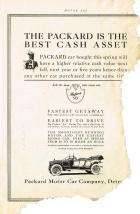|
Re: The consequential costs of a foolish or sloppy act
|
||||
|---|---|---|---|---|
|
Home away from home

|
You have to look at it this way: that 16lb cap just found what would eventually be a major problem when it failed, and probably at the most in-opportune time. I did the same thing on my '56, put a 16lb cap on it. I ended up replacing the radiator, and the heater core on the firewall because of this. It found all the weak points in the system for me, that's for sure!
BTW, the heater that's under the seat is for the rear seat passengers. You should have one on the passenger side firewall. If you don't, then someone removed it.
Posted on: 2008/7/13 19:53
|
|||
|
||||
|
Re: The consequential costs of a foolish or sloppy act
|
||||
|---|---|---|---|---|
|
Home away from home

|
This is a great story. I was going to say that a 7 pound cap is available from the NAPA Dealer for $4.00 or $5.00.
Along these same lines a story of my own. I got my 51 from a friend who couldn't keep it running so left it parked for 10 or so years. He told me He quit driving the car because every time he went out in the car it would overheat. He replaced the radiator and the water pump. Still overheated. He even went so far as to tell me he checked with a friend of his who owns two Packards and was told " Yea all those 51's over heat that's just the way they are." Sure enough when I started driving the car on almost any day I would loose coolant over the side. There is no overflow tank on a 51. One day I started the car after topping of the radiator coolant level and was messing with something else and noticed water running out the overflow pipe. The engine was just started and had not even warmed up yet. I found that at some time he had changed the radiator cap with the wrong one. The cap said 7 pounds all right but was designed for a radiator with about a 3/4" drop. The packard filler neck has a 1" drop. The rubber seal on the cap was 1/4" above the seat in the bottom of the filler neck. He might as well have left it off all together. Again the NAPA dealer came through and had the correct 7 pound cap with a 1" drop in stock. BTW ever try to buy simple things like a radiator cap or spark plugs from Kragen Auto? I get aggravated every time I drive by a Kragens. Lately has anybody said " Yes but who makes Packard, Ford or General Motors?
Posted on: 2008/7/13 20:01
|
|||
|
||||
|
Re: The consequential costs of a foolish or sloppy act
|
||||
|---|---|---|---|---|
|
Forum Ambassador
|
Out of curiosity, had your radiator been redone? They didn't have overflow tanks originally and I remember some time back in one of the forums someone had problems finding the proper 7# cap because the more modern cap necks are a bit shorter & wouldn't seal properly.
EDIT Bob47 just answered my question. Napa must be one of few carrying different lengths and Kragen/Autozone/PepBoys kinda a waste if you don't have Ford/Chevy--at least down here.
Posted on: 2008/7/13 20:03
|
|||
|
||||
|
Re: The consequential costs of a foolish or sloppy act
|
||||
|---|---|---|---|---|
|
Just can't stay away

|
HH56: You are very sharp.
First, yes, the radiator was repaired and rejuvenated in August of 2007 while owned by the previous owner - i.e. 11 months ago. I know this from the excellent provenance that came with the car. In addition, I checked that new cap, and found that underneath it, within the radiator "spout", there is a machined spacer. Evidently, the purpose of that machined spacer is to enable use of the shorter more modern radiator pressure caps in the Packard radiator. Either the prior owner, or someone before him, had installed that spacer, which by the way, is completely removable, thus enabling use of EITHER the longer Packard cap or the shorter modern cap. I wonder if the car had been running that 16 psi cap since that radiator overhaul 11 months ago. TurboPackMan: I don't regard this process as "finding the weak points". ANY system run at over twice its intended pressure is going to fail somewhere. At 7 psi, it might have been, and probably would have been, just fine. This is like pumping up a tire rated for 40 psi to 90 psi and then saying we "found the weak point" when it blows. That's not a valid test of the tire's integrity. Jim G
Posted on: 2008/7/13 21:38
|
|||
|
||||
|
Re: The consequential costs of a foolish or sloppy act
|
||||
|---|---|---|---|---|
|
Home away from home

|
Quote:
TurboPackMan: I don't regard this process as "finding the weak points". ANY system run at over twice its intended pressure is going to fail somewhere. At 7 psi, it might have been, and probably would have been, just fine. This is like pumping up a tire rated for 40 psi to 90 psi and then saying we "found the weak point" when it blows. That's not a valid test of the tire's integrity. Well, it worked, didn't it? LOL!
Posted on: 2008/7/13 22:29
|
|||
|
||||








